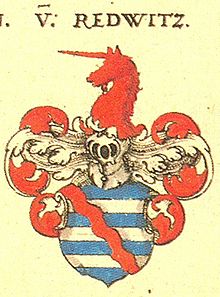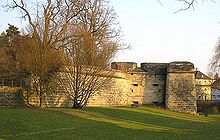Weigand von Redwitz




Weigand von Redwitz (* 1476 in Tüschnitz , † May 20, 1556 in Kronach ) was Prince-Bishop of the Bamberg Monastery from 1522 until his death in 1556 .
family
Weigand von Redwitz came from the Frankish imperial-free noble family von Redwitz (see also list of Frankish knight families ). The eponymous place is now called Redwitz an der Rodach and is a municipality in the Lichtenfels district in Upper Franconia . Katharina II von Redwitz († 1560) was abbess of the Obermünster monastery in Regensburg from 1533 to 1536 during Weigand's lifetime .
His father was Heinrich von Redwitz zu Theisenort and Tüschnitz , his mother Agatha was born from Bibra .
Life
Weigand von Redwitz had been a canon of Bamberg since 1490 . His pilgrimage to Jerusalem was a proof of his faith. In 1520 he was also the senior pastor of Kronach and thus the superior of Johannes Grau , who fled to Wittenberg a little later because of marriage to a Kronach citizen's daughter and was in contact with Martin Luther . During his time as bishop, Weigand took action against supporters of Luther and deposed sympathetic clergy. Under the moderating influence of the long-serving advisor Johann von Schwarzenberg , this was done less radically than some of his supporters would have liked in the election.
At the time of Weigand von Redwitz's appointment as Prince-Bishop, Hadrian VI was. Pope and Charles V Emperor. During his reign the Peasants' War raged in the region. Over 70 aristocratic seats in the diocese were destroyed, as well as various monasteries. Weigand tried to find diplomatic solutions. When armed conflicts could not be avoided, he resorted to the Swabian Federation . Military intervention by the federal government was also sought by the cathedral chapter, which at the beginning of the unrest had more rights than ever before and whose position was now existentially in question. Although individual canons showed themselves to be Protestant, the demands of the peasants, which meant their disempowerment, met with violent resistance from them. The military leader Georg Truchsess von Waldburg-Zeil was regarded as a loyal but also relentless military leader. His favorites were rewarded with the confiscated property of rich Bamberg families. As the victor over the peasant uprising, Weigand did not impose any draconian penalties. Even so, some leaders were beheaded in the marketplace.
He pledged Veldenstein Castle to the Burgraves of Nuremberg .
At the end of his reign, the Protestant Margrave Albrecht Alcibiades invaded the country in the Second Margrave War . Surprised by this, Weigand bowed to the margrave's exaggerated demands and ceded almost half of the prince-bishopric without significant resistance. Albrecht Alcibiades continued to secure his claims and conquered crucial centers in Forchheim and Bamberg . Since Albrecht Alcibiades had created many enemies with his actions, he was defeated in 1553 and died in 1557 as an outlawed person.
coat of arms
The Prince-Bishop's coat of arms is quartered. Fields two and three take up the family coat of arms of the von Redwitz family. In the case of Johann Siebmacher , these are three silver bars in blue, covered by a red diagonal wave bar . The other two fields show the black lion for Bamberg, covered with a silver sloping bar on a gold background.
Among other things , the coat of arms is attached to the St. Vitus Bastion of the Forchheim Fortress . There are also several specimens at the core of the Rosenberg Fortress in Kronach, the expansion of which Weigand von Redwitz had pushed forwards.
Grave monument in Michaelsberg Monastery
His grave monument, executed by Hans Polster, has been in the Michaelskirche since the style restoration of Bamberg Cathedral . It can be found there in the left aisle.
literature
- Friedrich Leitschuh : Wigand (Weigand) by Redwitz . In: Allgemeine Deutsche Biographie (ADB). Volume 42, Duncker & Humblot, Leipzig 1897, pp. 442-445.
- Thomas Löwer: The Swabian Federation in the Bamberg Monastery in 1525 - reasons for its intervention. GRIN Verlag GmbH, Munich 2007, ISBN 978-3-638-64212-5 (Also: Marburg, University, housework (advanced seminar), 2002).
- Werner Zeißner: Weigand von Redwitz (1476–1556). In: Gerhard Pfeiffer , Alfred Wendehorst (Ed.): Fränkische Lebensbilder (= publications of the Society for Franconian History. Series 7, A, Vol. 11). Volume 11. Kommissionsverlag Degener & Co, Neustadt / Aisch 1984, ISBN 3-7686-9082-2 , pp. 44-60.
Web links
- Portrait of Weigand von Redwitz in the story of the Klosterbräu
- Description of the coat of arms of the Prince-Bishop's multiple coat of arms
- Another coat of arms with ancestry
- Letter from Johannes Eck to the Prince-Bishop
- Letter from the Prince-Bishop to Ingolstadt's theological faculty
- The exemte diocese of Bamberg
- 1000 years of the Bamberg diocese - portrait of a bishop
- The bishop in the story of Pottenstein
- The bishop in the story of Nordhalben
- The bishop in the history of Bamberg
Individual evidence
- ↑ weber-rudolf.de
- ^ Convent building of the former Benedictine monastery of St. Michael. In: arch INFORM ; Retrieved December 1, 2009.
| predecessor | Office | successor |
|---|---|---|
| George III Gift of Limpurg |
Prince-Bishop of Bamberg 1522–1556 |
Georg IV. Fuchs of Rügheim |
| personal data | |
|---|---|
| SURNAME | Redwitz, Weigand von |
| BRIEF DESCRIPTION | Bishop of Bamberg |
| DATE OF BIRTH | 1476 |
| PLACE OF BIRTH | Tüschnitz |
| DATE OF DEATH | May 20, 1556 |
| Place of death | Kronach |

